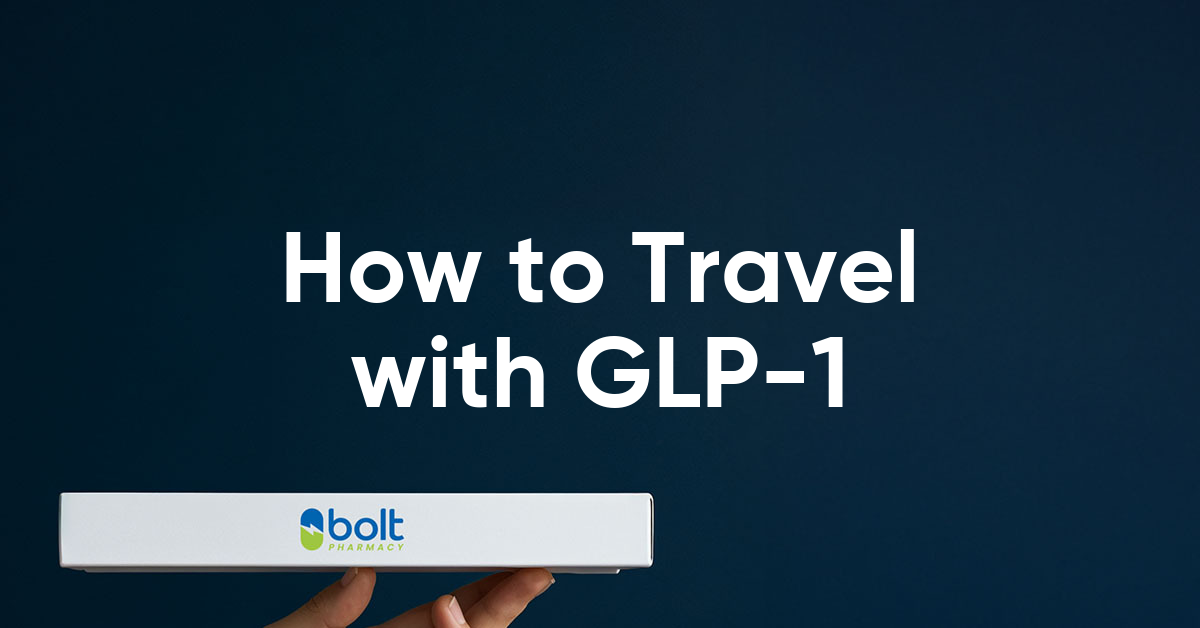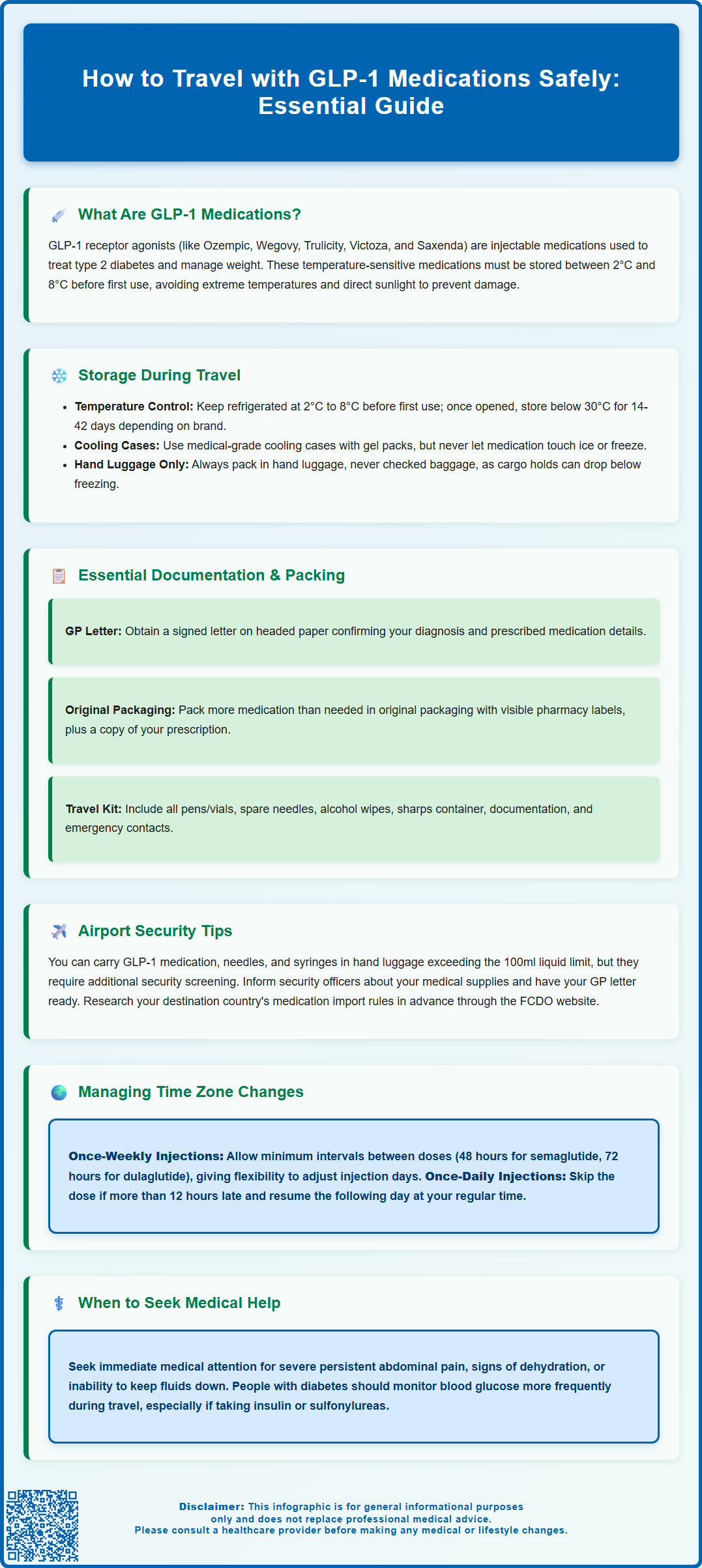Wegovy®
A weekly GLP-1 treatment proven to reduce hunger and support meaningful, long-term fat loss.
- ~16.9% average body weight loss
- Boosts metabolic & cardiovascular health
- Proven, long-established safety profile
- Weekly injection, easy to use

Travelling with GLP-1 medications such as Ozempic, Wegovy, Trulicity, or Saxenda requires careful planning to maintain medication efficacy and ensure continuity of care. These temperature-sensitive injectable treatments for type 2 diabetes and weight management must be stored correctly, transported safely, and administered on schedule, even when crossing time zones. Understanding airport security regulations, packing essential documentation, and preparing appropriate cooling solutions are vital steps for any journey. This guide provides practical advice on how to travel with GLP-1 medications safely, covering storage requirements, necessary paperwork, and managing your injection schedule whilst away from home.
Summary: GLP-1 medications require refrigeration before first use (2–8°C), must be carried in hand luggage with appropriate documentation, and need careful schedule management when crossing time zones.
Glucagon-like peptide-1 (GLP-1) receptor agonists are injectable medications prescribed for type 2 diabetes management and, for specific products, weight management. In the UK, common examples include semaglutide (Ozempic for diabetes; Wegovy for weight management), dulaglutide (Trulicity), and liraglutide (Victoza for diabetes; Saxenda for weight management). These medications work by mimicking the action of the naturally occurring GLP-1 hormone, which stimulates insulin secretion in response to food intake, suppresses glucagon release, slows gastric emptying, and reduces appetite.
GLP-1 medications require special consideration during travel primarily because they are temperature-sensitive injectable peptide medicines. Most formulations must be stored between 2°C and 8°C before first use, and even after opening, they should not be exposed to extreme temperatures or direct sunlight. Failure to maintain appropriate storage conditions can damage the medication, rendering it ineffective and potentially unsafe.
Additionally, as prescription-only injectable medications, carrying documentation when travelling with GLP-1 treatments is strongly recommended; requirements vary by country. Carrying syringes, pen devices, and medication vials without appropriate paperwork can raise concerns at airport security checkpoints. The NHS advises that patients should always travel with medications in their original packaging with pharmacy labels clearly visible.
For individuals managing chronic conditions such as diabetes, maintaining medication adherence whilst travelling is crucial for glycaemic control and preventing complications. Missed doses or improperly stored medication can lead to hyperglycaemia and increased HbA1c levels. The risk of hypoglycaemia with GLP-1 medications is generally low unless they are used in combination with insulin or sulfonylureas. Therefore, careful planning before any journey—whether domestic or international—is essential to ensure continuity of care and optimal therapeutic outcomes.
Proper storage of GLP-1 medications during travel is paramount to maintaining their efficacy and safety. Before first use , most GLP-1 injections must be refrigerated at 2°C to 8°C. Once in use, storage requirements vary by product:
Ozempic (semaglutide): Up to 6 weeks at or below 30°C
Wegovy (semaglutide): Up to 28 days at or below 30°C
Trulicity (dulaglutide): Up to 14 days at or below 30°C
Victoza/Saxenda (liraglutide): Up to 30 days at or below 30°C
Always consult your specific product's patient information leaflet or pharmacist for guidance, as storage requirements differ between brands.
When travelling, invest in a medical-grade cooling case or insulated travel pouch specifically designed for injectable medications. These products often contain gel packs that maintain stable temperatures for several hours. Avoid placing GLP-1 pens directly against ice or frozen gel packs, as freezing will permanently damage the medication. If your medication freezes, it must be discarded and replaced—do not use frozen or previously frozen GLP-1 injections.
For air travel, carry your GLP-1 medication in your hand luggage rather than checked baggage. Cargo holds can experience temperature extremes well below freezing, which will destroy your medication. Keep your medication away from direct sunlight, protect pens with their caps on, and avoid leaving them in hot vehicles, as temperatures above 30°C can degrade the active ingredient.
For extended trips requiring refrigeration, research your accommodation options in advance. Most hotels can provide refrigerator access upon request, and some will store medications in their kitchen facilities if in-room refrigeration is unavailable. When staying with friends or family, inform them of your storage needs beforehand. Consider using a portable medication thermometer to monitor storage conditions, particularly in unfamiliar environments. If you have any concerns about storage during your journey, contact your GP or pharmacist before departure for personalised advice.

Thorough preparation and appropriate documentation are essential when travelling with GLP-1 medications. It is recommended to obtain a letter from your GP or prescribing clinician on headed paper, confirming your diagnosis, prescribed medication (including generic and brand names), dosage, and the medical necessity of carrying syringes or injection devices. This letter should be dated and signed. Some countries may require this letter to be translated into the local language.
Ensure you pack sufficient medication to cover your entire trip plus extra in case of delays or unexpected itinerary changes. Keep your medication in its original packaging with the pharmacy label clearly visible, showing your name, medication name, dosage instructions, and prescribing pharmacy details. Carrying a copy of your repeat prescription is also advisable. Never transfer medication to unmarked containers, as this may cause issues at customs.
Your travel kit should include:
All prescribed GLP-1 pens or vials with sufficient doses
Spare needles (if using reusable pens)
Alcohol wipes for injection site preparation
A sharps container for safe needle disposal
Your GP letter and prescription documentation
Travel insurance documents confirming medication coverage
Contact details for your GP surgery and diabetes specialist team
A list of your medications (generic and brand names) in case you need emergency care abroad
Keep all GLP-1 medications in your hand luggage to avoid temperature extremes in the aircraft hold. If travelling with companions, you might distribute some supplies across different hand luggage bags for redundancy, but avoid placing any in checked baggage. Research the availability of your specific GLP-1 medication at your destination—some formulations may not be licensed or available in certain countries, making it crucial to bring adequate supplies from the UK. Also, enquire about local sharps disposal options at your destination; never place used needles in general waste.
Navigating airport security with injectable medications requires understanding current regulations and preparing appropriate documentation. In the UK, essential medicines in quantities needed for your journey may exceed the standard 100ml liquid restriction that applies to carry-on luggage, but they are subject to additional screening. You may carry your GLP-1 medication, along with associated needles and syringes, in your hand luggage.
When approaching security, inform the screening officer that you are carrying medical supplies and present your GP letter proactively. Whilst you are not legally required to show this documentation at UK airports, having it readily available expedites the process and prevents misunderstandings. Security staff may request to visually inspect your medication or pass it through additional screening, but they should not ask you to demonstrate injection or open sterile packaging.
For international travel, regulations vary by country. Research your destination's customs regulations well in advance through the Foreign, Commonwealth & Development Office (FCDO) website, which provides country-specific guidance on travelling with medications. Some nations require advance notification or specific permits for importing controlled medications.
Carrying cooling packs or gel packs for temperature-sensitive medication is permitted, but you should declare these to security staff and explain they are for medical use. They may be subject to additional screening.
Never pack your GLP-1 medication in checked baggage, as temperature fluctuations in cargo holds can render it ineffective. Ensure your travel insurance covers medication loss or damage, and know how to access emergency prescriptions abroad should the need arise. The Department for Transport (DFT) and Civil Aviation Authority (CAA) websites provide up-to-date information on UK airport security requirements for medicines and medical equipment.
Maintaining your GLP-1 injection schedule when crossing time zones requires careful planning to ensure therapeutic consistency whilst minimising side effects. Most GLP-1 medications are administered once weekly (such as semaglutide and dulaglutide) or once daily (such as liraglutide), and the approach to time zone management differs accordingly.
For once-weekly injections, product-specific guidance should be followed:
Ozempic (semaglutide): Requires at least 48 hours between doses. If needed, you can change your regular injection day provided there are at least 48 hours since your last dose. If you miss a dose, administer it as soon as possible within 5 days after the missed dose.
Trulicity (dulaglutide): Requires at least 72 hours between doses. If you miss a dose, administer it if there are at least 3 days before your next scheduled dose; otherwise, skip the missed dose.
Always consult your prescribing clinician before making significant changes to your dosing schedule.
For once-daily GLP-1 injections like Victoza or Saxenda (liraglutide), time zone changes require more careful consideration. When travelling eastward (e.g., UK to Asia), your day becomes shorter, potentially requiring a dose sooner than 24 hours after your previous injection. Conversely, westward travel (e.g., UK to North America) lengthens your day, potentially extending the interval between doses. For liraglutide products, if you miss a dose and more than 12 hours have passed, skip that dose and resume the next day.
A practical approach is to gradually adjust your injection time over several days before departure if possible. Alternatively, maintain your home time zone schedule for short trips (under one week), then transition to local time for longer stays. For individuals with diabetes using GLP-1 medications, monitor blood glucose levels more frequently during travel and time zone transitions, especially if also taking insulin or sulfonylureas, as changes in meal timing, activity levels, and sleep patterns can affect glycaemic control.
Keep a written record of your injection times during travel to maintain adherence. Seek urgent medical help if you experience severe persistent abdominal pain (with or without vomiting), signs of dehydration, or inability to keep fluids down, as these could indicate serious side effects. Report any suspected side effects via the MHRA Yellow Card Scheme (yellowcard.mhra.gov.uk).
Yes, you may carry GLP-1 medications, needles, and syringes in your hand luggage through UK airport security. Inform screening officers proactively and present your GP letter confirming medical necessity, though it is not legally required at UK airports.
If your GLP-1 medication freezes, it must be discarded immediately and replaced, as freezing permanently damages the active ingredient. Never use frozen or previously frozen GLP-1 injections, and always carry medication in hand luggage to avoid cargo hold temperature extremes.
For once-weekly GLP-1 medications, maintain minimum intervals between doses (48 hours for semaglutide, 72 hours for dulaglutide). For once-daily formulations like liraglutide, gradually adjust injection times over several days before departure, or maintain home time zone schedule for short trips under one week.
The health-related content published on this site is based on credible scientific sources and is periodically reviewed to ensure accuracy and relevance. Although we aim to reflect the most current medical knowledge, the material is meant for general education and awareness only.
The information on this site is not a substitute for professional medical advice. For any health concerns, please speak with a qualified medical professional. By using this information, you acknowledge responsibility for any decisions made and understand we are not liable for any consequences that may result.
Lorem ipsum dolor sit amet, consectetur adipiscing elit, sed do eiusmod tempor incididunt ut labore et dolore magna aliqua. Ut enim ad minim veniam, quis nostrud exercitation ullamco laboris nisi ut aliquip ex ea commodo consequat. Duis aute irure dolor in reprehenderit in voluptate velit esse cillum dolore eu fugiat nulla pariatur.
Block quote
Ordered list
Unordered list
Bold text
Emphasis
Superscript
Subscript